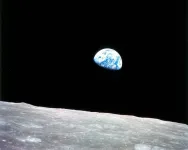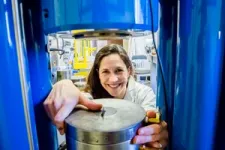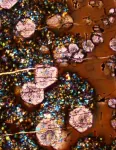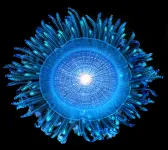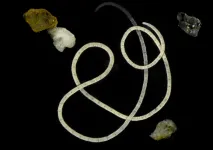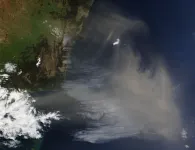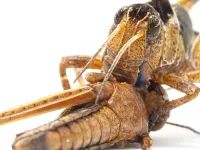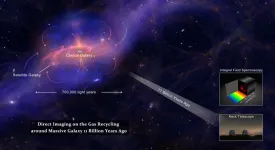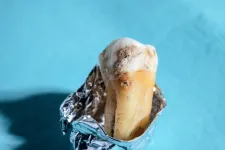(Press-News.org) Continents are part of what makes Earth uniquely habitable for life among the planets of the solar system, yet surprisingly little is understood about what gave rise to these huge pieces of the planet’s crust and their special properties. New research from Elizabeth Cottrell, research geologist and curator of rocks at the Smithsonian’s National Museum of Natural History, and lead study author Megan Holycross, formerly a Peter Buck Fellow and National Science Foundation Fellow at the museum and now an assistant professor at Cornell University, deepens the understanding of Earth’s crust by testing and ultimately eliminating one popular hypothesis about why continental crust is lower in iron and more oxidized compared to oceanic crust. The iron-poor composition of continental crust is a major reason why vast portions of the Earth’s surface stand above sea level as dry land, making terrestrial life possible today.
The study, published today in Science, uses laboratory experiments to show that the iron-depleted, oxidized chemistry typical of Earth’s continental crust likely did not come from crystallization of the mineral garnet, as a popular explanation proposed in 2018.
The building blocks of new continental crust issue forth from the depths of the Earth at what are known as continental arc volcanoes, which are found at subduction zones where an oceanic plate dives beneath a continental plate. In the garnet explanation for continental crust’s iron-depleted and oxidized state, the crystallization of garnet in the magmas beneath these continental arc volcanoes removes non-oxidized (reduced or ferrous, as it is known among scientists) iron from the terrestrial plates, simultaneously depleting the molten magma of iron and leaving it more oxidized.
One of the key consequences of Earth’s continental crust’s low iron content relative to oceanic crust is that it makes the continents less dense and more buoyant, causing the continental plates to sit higher atop the planet’s mantle than oceanic plates. This discrepancy in density and buoyancy is a major reason that the continents feature dry land while oceanic crusts are underwater, as well as why continental plates always come out on top when they meet oceanic plates at subduction zones.
The garnet explanation for the iron depletion and oxidation in continental arc magmas was compelling, but Cottrell said one aspect of it did not sit right with her.
“You need high pressures to make garnet stable, and you find this low-iron magma at places where crust isn’t that thick and so the pressure isn’t super high,” she said.
In 2018, Cottrell and her colleagues set about finding a way to test whether the crystallization of garnet deep beneath these arc volcanoes is indeed essential to the process of creating continental crust as is understood. To accomplish this, Cottrell and Holycross had to find ways to replicate the intense heat and pressure of the Earth’s crust in the lab, and then develop techniques sensitive enough to measure not just how much iron was present, but to differentiate whether that iron was oxidized.
To recreate the massive pressure and heat found beneath continental arc volcanoes, the team used what are called piston-cylinder presses in the museum’s High-Pressure Laboratory and at Cornell. A hydraulic piston-cylinder press is about the size of a mini fridge and is mostly made of incredibly thick and strong steel and tungsten carbide. Force applied by a large hydraulic ram results in very high pressures on tiny rock samples, about a cubic millimeter in size. The assembly consists of electrical and thermal insulators surrounding the rock sample, as well as a cylindrical furnace. The combination of the piston-cylinder press and heating assembly allows for experiments that can attain the very high pressures and temperatures found under volcanoes.
In 13 different experiments, Cottrell and Holycross grew samples of garnet from molten rock inside the piston-cylinder press under pressures and temperatures designed to simulate conditions inside magma chambers deep in Earth’s crust. The pressures used in the experiments ranged from 1.5 to 3 gigapascals—that is roughly 15,000 to 30,000 Earth atmospheres of pressure or 8,000 times more pressure than inside a can of soda. Temperatures ranged from 950 to 1,230 degrees Celsius, which is hot enough to melt rock.
Next, the team collected garnets from Smithsonian’s National Rock Collection and from other researchers around the world. Crucially, this group of garnets had already been analyzed so their concentrations of oxidized and unoxidized iron were known.
Finally, the study authors took the materials from their experiments and those gathered from collections to the Advanced Photon Source at the U.S. Department of Energy’s Argonne National Laboratory in Illinois. There the team used high-energy X-ray beams to conduct X-ray absorption spectroscopy, a technique that can tell scientists about the structure and composition of materials based on how they absorb X-rays. In this case, the researchers were looking into the concentrations of oxidized and unoxidized iron.
The samples with known ratios of oxidized and unoxidized iron provided a way to check and calibrate the team’s X-ray absorption spectroscopy measurements and facilitated a comparison with the materials from their experiments.
The results of these tests revealed that the garnets had not incorporated enough unoxidized iron from the rock samples to account for the levels of iron-depletion and oxidation present in the magmas that are the building blocks of Earth’s continental crust.
“These results make the garnet crystallization model an extremely unlikely explanation for why magmas from continental arc volcanoes are oxidized and iron depleted,” Cottrell said. “It’s more likely that conditions in Earth’s mantle below continental crust are setting these oxidized conditions.”
Like so many results in science, the findings lead to more questions: “What is doing the oxidizing or iron depleting?” Cottrell asked. “If it’s not garnet crystallization in the crust and it’s something about how the magmas arrive from the mantle, then what is happening in the mantle? How did their compositions get modified?”
Cottrell said that these questions are hard to answer but that now the leading theory is that oxidized sulfur could be oxidizing the iron, something a current Peter Buck Fellow is investigating under her mentorship at the museum.
This study is an example of the kind of research that museum scientists will tackle under the museum’s new Our Unique Planet initiative, a public–private partnership, which supports research into some of the most enduring and significant questions about what makes Earth special. Other research will investigate the source of Earth’s liquid oceans and how minerals may have served as templates for life.
This research was supported by funding from the Smithsonian, the National Science Foundation, the Department of Energy and the Lyda Hill Foundation.
# # #
END
The North Pacific “Garbage Patch” is home to an abundance of floating sea creatures, as well as the plastic waste it has become famous for, according to a study by Rebecca Helm from Georgetown University, US, and colleagues, publishing April 27th in the open access journal PLOS Biology.
There are five main oceanic gyres — vortexes of water where multiple ocean currents meet — of which the North Pacific Subtropical Gyre (NPSG) is the largest. It is also known as the North Pacific “Garbage Patch”, because converging ocean currents have concentrated large amounts ...
Cholesterol and phytosterol are sterols, fatty compounds essential for many biological processes such as the functioning of cell membranes. Up to now, it has been assumed that phytosterols are characteristic for plants, and cholesterol for animals, and that only plants can make phytosterols, while animals typically make cholesterol. Dolma Michellod, Nicole Dubilier and Manuel Liebeke from the Max Planck Institute for Marine Microbiology in Bremen, Germany, were therefore surprised when they discovered that a small marine worm called Olavius ...
CORVALLIS, Ore. – New research led by an Oregon State University scientist begins to unravel the role dust plays in nourishing global ocean ecosystems while helping regulate atmospheric carbon dioxide levels.
Researchers have long known that phytoplankton – plantlike organisms that live in the upper part of the ocean and are the foundation of the marine food web – rely on dust from land-based sources for key nutrients. But the extent and magnitude of the impact of the dust – ...
Huge swarms of migratory locusts take on the proportions of natural disasters and threaten the food supply of millions of people, especially in Africa and Asia. As the eighth of the ten biblical plagues, the Book of Moses in the Old Testament already describes how swarms of locusts darkened the sky and ate up everything that grew in the fields and on the trees. Scientists suspect that cannibalism among locusts contributes to their swarming behavior, and swarms therefore constantly move ...
Swarming migratory locusts – which threaten food security across the globe – avoid being eaten by other locusts by producing a smelly pheromone called phenylacetonitrile (PAN), according to a new study. The discovery of an anticannibalistic signaling pathway in locusts could provide a target for locust management strategies since cannibalistic interactions among locusts have been implicated in creation of swarms, which are highly destructive. A wide range of species practice cannibalism, mostly to supplement nutrition. This has led to the evolution of ...
A randomized controlled experiment featuring more than 26,000 students across 22 4-year U.S. universities shows that the effects of a low-cost, brief online intervention focused on social belonging can promote success and equity for college students. This finding was particularly apparent among those from groups that have historically achieved at lower rates. The likelihood of earning a university degree in the U.S. is highly unequal across racial-ethnic and socioeconomic groups. In most cases, programs designed to help, by promoting college persistence, work differently for different people. Understanding these heterogenous effects ...
Streams of intergalactic gas, enriched with elements heavier than helium, encircle and spiral into a massive galaxy observed at redshift 2.3, researchers report. The findings provide evidence of enriched gas recycling during galaxy formation in the early Universe. Galaxies form through the accretion of gas from the circumgalactic medium (CGM) and intergalactic medium (IGM), which subsequently condenses into stars. Simulations and observations have shown that cold stream accretion – the accumulation of pristine intergalactic gas that contains almost no elements heavier ...
Reconstructing the bacterial genomes recovered from the calcified plaque of human and Neanderthal remains has offered new insights into previously undescribed Pleistocene bacterial metabolites, researchers report. The approach expands researchers ability to study microbial natural products, which has otherwise been mostly limited to studying living bacteria. Bioactive small molecules produced by microbes, often called natural products, have been an important source of diverse functional compounds for industry and medicine, including many antimicrobials. Characterizing the natural products encoded in biosynthetic gene clusters ...
A major challenge in human genetics is understanding which parts of the genome drive specific traits or contribute to disease risk. This challenge is even greater for genetic variants found in the 98% of the genome that does not encode proteins.
A new approach developed by researchers at New York University and the New York Genome Center combines genetic association studies, gene editing, and single-cell sequencing to address these challenges and discover causal variants and genetic mechanisms for ...
USC President Carol L. Folt on Thursday announced a $1 billion-plus initiative for computing research and education across disciplines, with a focus on AI, machine learning and data science, augmented and virtual reality, robotics, gaming and block chain.
“I want every student who comes through our programs, whether they are in science, business, the humanities or the arts, to have a solid grounding in technology and the ethics of the work that they do,” Folt said. “We will integrate digital literacy across disciplines to create responsible leaders for the workforce of the future.”
Seeded with a $260 million gift from the ...
